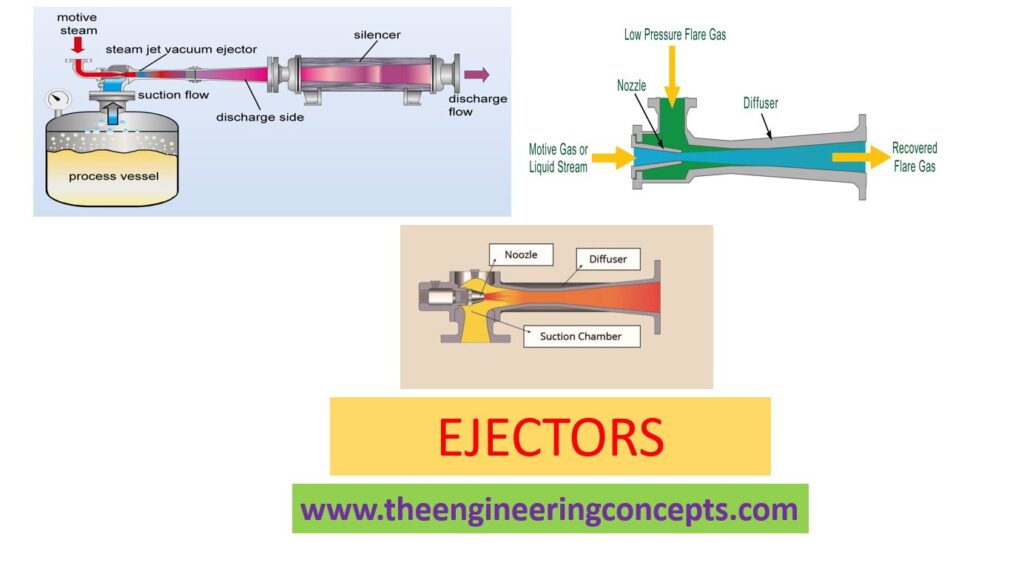There are many names for ejectors such as eductors, surface jet pumps, thermocompressor, venturi’s spool, velocity spool, etc. The operating principle of ejector is same among all irrespective of their names. Ejectors offer a reliable technology to recover high pressure steam, emission of surplus and waste gases to conserve energy by reusing them in production. It is also called a pumping device.
Aricle written By : Pallavi Wankhede
Types of ejectors:
Depending on the nozzle orientation and requirements, ejectors are classified as single-stage nozzle type, multiple-stage nozzle type. On the other hand, based on the requirements of process and fluid used in the ejectors, it is further classified as steam jet ejectors, liquid jet ejectors, combined steam and liquid jet ejectors, steam jet vacuum ejectors, etc.
Read Also : Cooling Tower
Read Also : Three Phase Seperator
Working Principle:
- Ejector is a static device which works on Bernoulli’s Principle or venturi effect (when the velocity of fluid increases, there is a decrease in pressure and vice versa).
- It mainly consists of these four parts: motive fluid, suction chamber, diffuser and nozzle.
Video : Steam Ejectors
- Motive fluid can be anything that further can be compressed by ejector. It is usually steam, gas or air.
- Motive fluid is provided through the inlet (yellow arrow in fig.4) of the ejector and the low pressure flare gas from the process vessel or reactor (yellow arrow fig. 4). Afterward, it is passed through the nozzle. During the process, motive fluid is compressed and accelerated. Once the motive fluid passed through the nozzle, due to a change in cross sectional flow area (cone shape after nozzle), the compressed fluid slows down and the recovered gas obtained in suction chamber will be discharged with the help of a diffuser (yellow arrow fig 4).
- In general, ejectors convert the pressure energy (potential energy) of the motive fluid to velocity energy (kinetic energy). It is accomplished through adiabatic expansion from the supply pressure of the motive fluid to the suction pressure load created in the suction chamber. As motive fluid flows through a nozzle, it expands at high pressure and reduces the velocity of the fluid. In this way, waste gas (flare gas) can be recovered and added to the production.
Read Also : Sensor and Types of Sensors
Selection and Efficiency:
- In the case of vacuum jet ejectors, due to their static and compact structure, there will be less wear and tear. Also, the maintenance cost is quite low. Vacuum jet ejectors used motive fluid as compressed air.
- Steam jet vacuum ejectors can be used to remove the gases and vapor generated during the process and generate vacuum in the reactor (refer the image which has mounted ejector on the vessel). It provides high vacuum level with small flowrate. Its maintenance cost is quite low. Steam jet ejectors are used, when motive fluid is water.
- In the case of single-stage ejectors, the suction flow is average and the initial cost is low due to single and compact nozzle. Also, the evacuation time is short and the noise generation is high. It is used in critical as well as non-critical flow conditions. It is preferred in one set of design condition due to its single nozzle. It is mainly used to achieve high compression ratios.
- On the other hand, multi-stage ejectors give high suction flowrate and generate low noise. In addition to this, the initial cost is high and the evacuation time is very short. Due to the multiple nozzles, it is used to reduce the steam consumption by 9-17 % as compared to the single-stage ejector and thus it is more efficient. Also, its length is considerably short.
- It helps to provide continuous flow through suction media.
- Ejector eliminates the chances of fire or explosion as there are no moving parts in it.
- Ejectors usually don’t have space issues due its lightweight and easy handling. It can be mounted anywhere on the device.
- It is the most suitable equipment in hazardous areas like steam generation systems, crude oil distillation, thermal power plants, petrochemicals, fertilizers, deodorization of oil, degassing of metal vacuum, etc.
Content source: transvac; DAS Services; shailvac; koerting
Image Source: koerting; ironpump; ipieca
Video Source: Croll Reynolds

